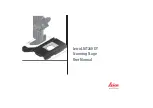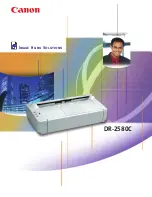
Service Guide IQ / IQ Quattro
98
Edit
Modify an entry using standard Windows text-editing techniques.
Emulsion
The light sensitive silver, coated on the clear acetate film base, that forms the photograph when a picture is taken and the film is developed.
Equalizing
Distributing all color or tone equally along a density range.
File Format (image)
The format in which a scanned picture is saved. Many programs can insert or import a picture from a file, if it is saved in a file format that the program supports.
Common file formats include TIFF (Tagged Image File Format), BMP (Windows bitmap), JPEG (Joint Photograph Expert Group), and FPX (FlashPix format).
Flip Horizontal
To flip the picture left/right.
Foreground
Foreground when scanning raster data (black and white, or monochrome data) refers to the pixels that represent data of interest (background refers to everything
else). Typically, lines and shapes are represented by black pixels (foreground) and empty space is represented by white pixels (background). When scanning
grayscale data, background means the gray level of a region of pixels that surrounds some desired foreground data.
Gamma Adjustment
An adjustment that makes the tone distribution lighter or darker in an image.
Gamut Transformation
Color Management System function, where out-of-gamut colors are converted to colors within the gamut of the targeted device, e.g., a printer.
Gamut
The color range scanable, printable or displayable by a device; e.g., if some of the displayable colors are outside of the gamut of the printer they cannot be printed.
GCR
Gray component replacement. A color separation setting used on color photographs where cyan, magenta and yellow inks are replaced by black ink (in a balance
that would yield a gray value). The advantages are a reduction in overall ink usage and some increase in image detail.
Grayscale
A term for a black and white photographic image or a scanner setting. Refers to the range of 256 gray tones that make up the image.
Half-toning
The processes of offset printing and laser printing are intrinsically bilevel. However, these devices can reproduce a range of tone levels by halftoning; e.g., an array
of widely spaced dots produces the perception of light gray, and an array of tightly spaced dots produces dark gray. Halftone dots are usually placed in a regular
grid. In color printing it is conventional to use cyan, magenta, yellow and black grids that have exactly the same dot pitch but different carefully-chosen screen
angles.
Summary of Contents for IQ 2400 Series
Page 9: ...Service Guide IQ IQ Quattro 9 Block Diagram MN52D MR52D...
Page 10: ...Service Guide IQ IQ Quattro 10 Block Diagram MT52D...
Page 11: ...Service Guide IQ IQ Quattro 11 Wiring Diagram MN52D MR52D IQ 4400 MN52D IQ Quattro 4400 MR52D...
Page 12: ...Service Guide IQ IQ Quattro 12 Wiring Diagram MT52D IQ Quattro 3600 MT52D...
Page 14: ...Service Guide IQ IQ Quattro 14 Scanner Controller Board Layout SURA...
Page 15: ...Service Guide IQ IQ Quattro 15 Scanner Controller Board Layout SUTA...
Page 16: ...Service Guide IQ IQ Quattro 16 Scanner Controller Board Layout SUTK...
Page 19: ...Service Guide IQ IQ Quattro 19 Block Diagram MP52D MQ52D...
Page 20: ...Service Guide IQ IQ Quattro 20 Wiring Diagram MP52D MQ52D IQ 2400 IQ Quattro 2400...
Page 22: ...Service Guide IQ IQ Quattro 22 Scanner Controller Board Layout SURB...
Page 23: ...Service Guide IQ IQ Quattro 23 Scanner Controller Board Layout SUTB...
Page 32: ...Service Guide IQ IQ Quattro 32 Identifying parts...
Page 36: ...Service Guide IQ IQ Quattro 36 LHS Cover 1 Remove screws and cover x2 Torx 20...
Page 56: ...Service Guide IQ IQ Quattro 56 Identifying parts...
Page 60: ...Service Guide IQ IQ Quattro 60 LHS Cover 1 Remove screws and cover x2 Torx 20...
















































